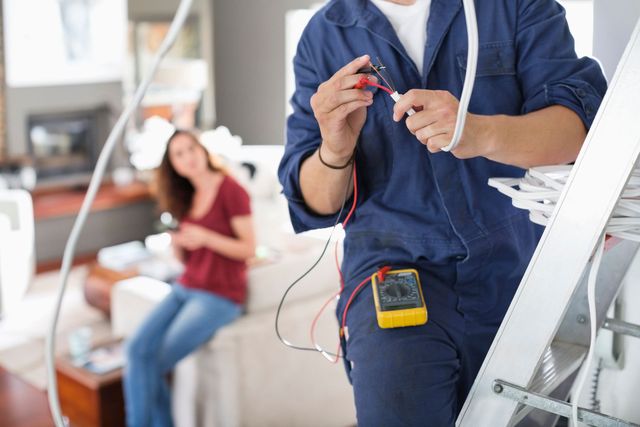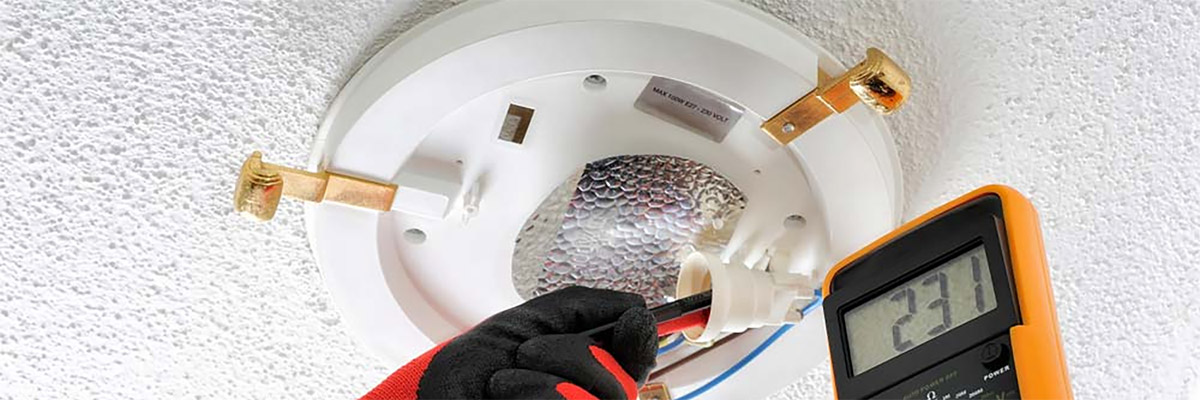Usual Electric Issues Every Property Owner Need To Find out about
Homeowners often come across numerous electrical issues that can impact security and performance. Concerns like flickering lights and tripped breaker are more typical than several recognize. These situations can indicate much deeper electric concerns that warrant attention. Recognizing the signs and dangers related to obsolete wiring and dead outlets is important. What measures can be required to avoid these problems? Discovering these common electrical concerns might expose vital understandings for keeping a risk-free home setting.

Flickering Lights: Reasons and Solutions
Why do some homeowners experience flickering lights? Flickering lights can be an usual inconvenience, commonly indicating underlying electrical problems. One main cause is loosened or damaged links within light components or wiring, which can bring about intermittent power supply. Furthermore, using high-wattage home appliances on the same circuit may create voltage changes, resulting in dimming or flickering. One more prospective issue is an overloaded circuit, where way too many tools draw power at the same time, stressing the electric system. Degraded or outdated circuitry can add to irregular electric circulation. In some cases, flickering lights might signal a problem with the home's electrical panel or service line. Home owners ought to deal with flickering lights quickly to avoid prospective hazards. Solutions may include tightening up links, redistributing home appliance lots, or speaking with a licensed electrician for a complete assessment. Determining the origin can assist guarantee a secure and secure electrical system in the home.
Tripped Circuit Breakers: What You Required to Know
Have homeowners ever questioned what triggers their circuit breakers to journey unexpectedly? This usual problem commonly occurs from an overload of electrical circuits, where too many tools attract power at the same time. In such instances, the circuit breaker acts as a safety and security mechanism, interrupting the circulation of electrical power to avoid getting too hot and potential hazards. Another constant reason is a short circuit, which happens when a live cable get in touches with a neutral cord, developing a surge of electricity that journeys the breaker. Ground mistakes can additionally lead to stumbled breakers; these take place when an online cord touches the ground or a grounded surface area, positioning major safety and security risks. House owners ought to routinely analyze their usage of high-wattage home appliances to avoid straining circuits. Additionally, comprehending the feature of circuit breakers can aid them respond properly during a trip, ensuring their home continues to be well-maintained and safe.
Obsolete Circuitry: Signs and Dangers
Out-of-date electrical wiring can posture considerable threats to homeowners, typically going undetected till issues emerge. Residences constructed prior to the 1980s may still have light weight aluminum electrical wiring or knob-and-tube systems, which are no much longer taken into consideration safe. Indications of out-of-date wiring consist of flickering lights, regularly stumbled breaker, or melting smells near outlets. These signs may recommend that the electric system is loaded down or deteriorating.Additionally, homeowners might see blister marks around buttons or outlets, which can indicate getting too hot. The threat of electrical fires substantially raises with obsolete electrical wiring, as these systems were not created to manage contemporary electrical tons. Homeowners are urged to have their electrical wiring evaluated consistently, particularly when restoring or including new devices. By identifying these indicators early, they can prevent harmful circumstances and preserve a safer living setting. Upgrading to current electrical criteria is a positive step in keeping home safety and performance.
Often Blown Fuses: Repairing Tips
Frequent blown fuses can indicate underlying electrical issues that might originate from out-of-date wiring or overloaded circuits. House owners experiencing this trouble must initially recognize the devices attached to the influenced circuit. It is a good idea to prevent using numerous high-wattage tools concurrently, as this can lead to circuit overload. If the issue persists, examining the fuse box for indicators of wear or damage is crucial; a defective fuse box might call for replacement.Additionally, inspecting for loose connections within the circuit can aid stop future incidents. Property owners ought to also verify that the fuses being made use of are of the appropriate amperage, as making use of an inaccurate fuse can exacerbate the issue. If these repairing tips do not settle the issue, getting in touch with a certified electrician is advised to review the electric system further. Dealing with these worries immediately can aid reduce dangers and ensure the safety of the home's electric infrastructure.
Dead Outlets: Usual Reasons and Fixes
When a house owner runs into a dead electrical outlet, it can commonly be a resource of irritation and complication. A number of common causes might cause this concern. One constant culprit is a tripped breaker, which can be conveniently reset. If any breakers are in the off placement, homeowners should examine their electrical panel to inspect. One more look at this website possibility is a malfunctioning electrical outlet itself, which may call for replacement. Furthermore, loosened electrical wiring connections within the electrical outlet can interrupt power circulation, making examination essential.Sometimes, the issue may originate from an overloaded circuit, specifically when several devices are linked. In such instances, redistributing the electrical tons can settle the issue. Property owners ought to additionally take into consideration the age of their electrical wiring; older systems might need updates to meet modern-day electrical needs. If these steps do not rectify the scenario, consulting a licensed electrical contractor is a good idea to assure safety and security and proper medical diagnosis.
Electric Shocks: When to Be Concerned
Exactly how can property owners establish whether an electrical shock warrants worry? Property owners should initially assess the seriousness and context of the shock. A light fixed shock, often really felt when touching metal items, is usually harmless and typical. Nevertheless, if the shock takes place while communicating with a plugged-in home appliance or electrical outlet, it may suggest a much more severe issue.The area and frequency of the shocks are crucial. Repeated shocks from the same source, particularly in wet locations like kitchens or shower rooms, can signal faulty circuitry or poor grounding. House owners ought to likewise take into consideration the experience of the shock; a shock that causes pain or contraction is more disconcerting than a plain tingle.If there's any kind of unpredictability, it is a good idea to get in touch with a certified electrical contractor. Neglecting possible electrical risks can lead to major safety risks, including fire or serious injury.
Overloaded Circuits: Prevention and Security Measures
Overloaded circuits posture significant threats in residential setups, commonly causing electric fires or tools damages (Level 2 Electrician Sydney). Homeowners should identify the indications of an overloaded circuit, such as frequently stumbled breakers or dimming lights. Executing preventive safety and security methods can aid reduce these risks and assure a much safer living setting
Acknowledging Overloaded Circuits
What indications show that a circuit may be overloaded? Homeowners should be attentive for numerous crucial indicators. Regularly stumbled breaker or blown integrates suggest too much load on the circuit. Lowering or flickering lights, especially when other devices remain in use, can indicate an inadequate power supply. Furthermore, electrical outlets or buttons that really feel warm to the touch might suggest overheating, a prospective fire threat. Unusual buzzing audios from outlets also call for focus, as they can signify electrical problems. If devices run inefficiently or stop working to begin, it might be an indicator of an overloaded circuit. Acknowledging these indications early can aid avoid severe electric problems and promote a much safer home atmosphere.
Preventive Security Practices
To maintain a effective and risk-free electrical system, home owners should apply precautionary safety and security methods that resolve possible circuit overloads. One efficient procedure is to prevent linking a lot of gadgets to a single electrical outlet, as this can go beyond the circuit's ability. Using power strips with integrated circuit breakers can help distribute power safely. House owners must likewise on a regular basis inspect cords and appliances for damage and change any kind of defective devices promptly. It is crucial to assure that breaker are operating correctly and to be knowledgeable about the overall wattage being utilized in each circuit. Additionally, consulting a certified electrical contractor for routine assessments can determine possible issues prior to they intensify, guaranteeing a more secure living atmosphere and lengthening the life expectancy of electrical systems.
Regularly Asked Questions
Just how Often Should I Have My Electrical System Inspected?
Normal evaluations of electric systems are recommended every three to 5 years. House owners ought to take into consideration much more frequent checks if they experience issues, carry out renovations, or live in older residential or commercial properties to guarantee security and compliance.
Can I Repair Electrical Troubles Myself or Work With an Expert?

What Are the Signs of an Electrical Fire Risk?
Signs of an electrical fire threat consist of regularly stumbled circuit breakers, flickering lights, shedding smells, stained outlets, or cozy, buzzing wires. Home owners ought to remain cautious and seek expert help if any one of these indications exist.
How Do I Know if My Home Needs an Electric Upgrade?
To figure out if a home requires an electric upgrade, indicators include frequent circuit breaker trips, look at here outdated electrical wiring, not enough electrical outlets, flickering lights, and the visibility of older electric panels, suggesting prospective safety risks and ineffectiveness.
Exist Details Safety Tips for Do It Yourself Electrical Job?
When taking into consideration DIY electrical job, one must constantly transform off power, utilize this hyperlink shielded devices, verify circuit capability, follow regional codes, and consult experts for intricate jobs to guarantee safety and prevent accidents. One more potential concern is an overloaded circuit, where as well many gadgets draw power at the same time, straining the electrical system. The threat of electric fires significantly increases with obsolete circuitry, as these systems were not created to take care of modern-day electrical loads. Frequent blown integrates can show underlying electrical issues that might stem from obsolete circuitry or overloaded circuits. To preserve a efficient and secure electrical system, property owners need to implement precautionary safety techniques that deal with prospective circuit overloads. ASP Level 2 Electrician. Indicators of an electric fire risk consist of often stumbled circuit breakers, flickering lights, burning smells, stained electrical outlets, or warm, humming wires
Comments on “Appliances kill your lights? Ask a Level 2 Electrician Sydney”